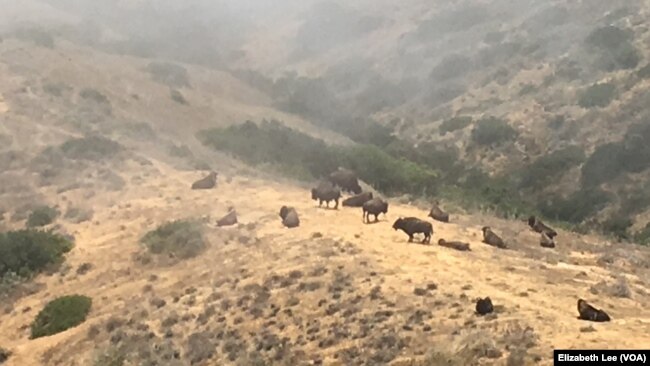 The bison of Catalina Island are smaller than those on the mainland. It's not because of a genetic difference, they just don't get the right nutrients at the right time, according to Julie King, director of conservation and wildlife management at the Cata
The bison of Catalina Island are smaller than those on the mainland. It's not because of a genetic difference, they just don't get the right nutrients at the right time, according to Julie King, director of conservation and wildlife management at the Cata
CATALINA ISLAND, CALIFORNIA —
Countless visitors to Santa Catalina Island off the coast of California take a rough, bumpy ride into the island’s interior in hopes of finding a piece of Hollywood history.
“In 1924, approximately 14 bison were brought to the island for the filming of a movie, and they did not end up being in the movie, but when the film crew left, the bison were left behind and have been on the landscape ever since,” said Julie King, director of conservation and wildlife management at the Catalina Island Conservancy.
Currently, 120 bison remain on the island, but they were not native to the island.
 At one time, the bison of Catalina Island, pictured here as fog rolls in, numbered as many as 600. Since then, almost 500 have found new homes on Native American reservations.
At one time, the bison of Catalina Island, pictured here as fog rolls in, numbered as many as 600. Since then, almost 500 have found new homes on Native American reservations.
Nearly extinct
In prehistoric times, but by the late 1800s, they were nearly extinct. Through conservation efforts, they can now be found in all 50 states, including national parks, private lands and on one of the Channel Islands off the coast of southern California.
While five of the eight Channel Islands are part of the National Park Service, Catalina Island is not. Most of the island is now owned by the Catalina Island Conservancy, which manages the bison there.
“They’re very challenged healthwise when they’re on this island because they don’t have the adequate nutrition during the right time of year,” King said. “So, our bison are in fact a little smaller than the mainland, and it’s not a genetic difference. It’s due to not having the right nutrients at the right time.”
The bison do not have predators that are native to the island, and they live in a mild climate in contrast to their counterparts on the mainland, which often have to survive harsh winters. Eventually, the bison on Catalina Island had grown to numbers that the island could not sustain. According to the conservancy, the herd’s numbers were rumored to have reached up to 600 at their peak
Blogger Comment
Facebook Comment